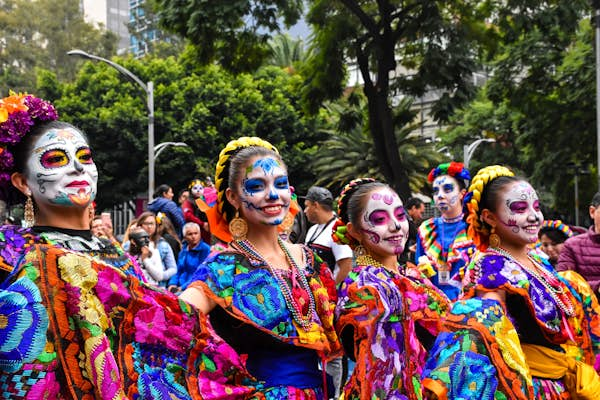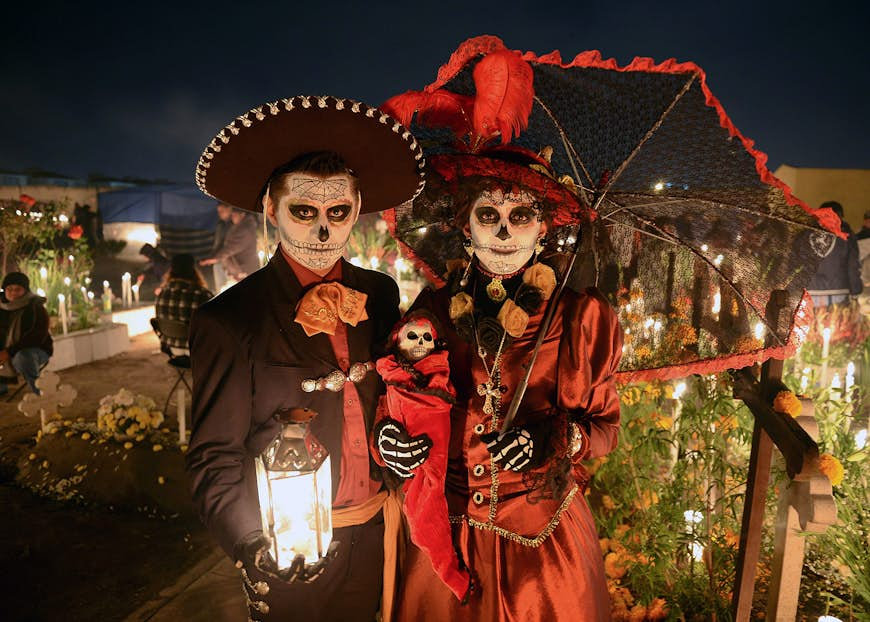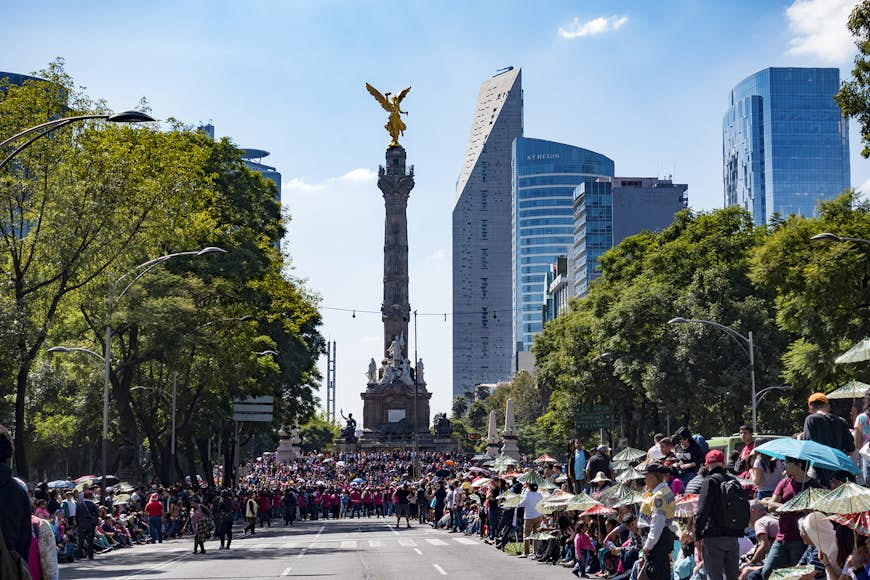
From late October to early November, visitors flock to Mexico for Día de Muertos (Day of the Dead). An annual remembrance of departed souls, the holiday earned a designation as an ‘intangible cultural heritage’ by Unesco in 2003 and encapsulates the country’s upbeat treatment of mortality, making it one of the world’s most universally familiar festivals.
During the celebration, city streets come to life with festively macabre decorations – papier-mâché skeletons, children eating candy skulls, shops selling marzipan coffins and locals going about their days dressed in skeleton costumes. Mexicans and visitors alike use this time to celebrate life as well, and the festivities are full of music, food and family.
Best time to visit Mexico
 The elaborately costumed revelry of Día de Muertos even extends to Mexico’s cemeteries © MARIO VAZQUEZ / Getty Images
The elaborately costumed revelry of Día de Muertos even extends to Mexico’s cemeteries © MARIO VAZQUEZ / Getty Images
The Día de Muertos tradition
In a belief system inherited from the Aztecs and corrupted by Catholic conquistadors, many Mexicans believe their dead reside in a place called Mictlān, and can return to their homes at this time of year. The celebrations originally occurred throughout the month of August, but the Catholic conquistadors, hoping to assimilate the holiday through their favored tactic of cultural mestizaje (mixing), moved it to the day after All Saints’ Day.
9 US cities that do Día de Muertos right
While Día de Muertos technically takes place from the night of 1 Nov through the next day, festivities celebrating the event stretch to cover a full week. Parades highlighting the holiday’s most famous skeleton character – a representation of Death herself called La Calavera Catrina, popularized in art by Diego Rivera – serve as a lead-in to main events, particularly in Mexico City, where the colorful Grand Procession of the Catrinas kicks off in the Zocálo and winds its way through the capital’s streets. This year’s event will take place on Saturday, October 29.
Get the inside scoop on the latest cultural happenings all over the world delivered weekly to your inbox with our email newsletter.  The many colorful costumes of a Día de Muertos celebration © Moab Republic / Shutterstock
The many colorful costumes of a Día de Muertos celebration © Moab Republic / Shutterstock
Preparing for the holiday
In the run-up to Día de Muertos, families make paths to help spirits find their way home and be welcomed, starting with an arch made of bright-yellow marigolds – a symbolic doorway from the underworld. An altar or ofrenda is erected and piled high with offerings to the visitors: flowers, ribbons, colored candles, tamales (steam-cooked cornmeal dough), fruit and corn. Two important additions are a container of water – spirits arrive thirsty after their journey – and pan de muerto (bread of the dead). This loaf is made with egg yolks, fruits and tequila or mezcal, and is adorned with, or shaped as, a symbol of death. Families also cook the favorite dishes of their deceased loved ones.
The celebration peaks with a visit to the cemetery. There might be a carnival en route, with neon-lit rides and stands selling crucifix waffles and nopal (cactus) snacks. Families devote a day to cleaning the graves, decorating them with candles and flores del cempasúchil (marigold flowers of the dead), having picnics and dancing to mariachi bands. By now, the streets are full of papel picado (colorful, perforated paper flags) and papier-mâché skeletons in dresses, jewelry, flowery boas and hats.
Here’s how you can celebrate Day of the Dead at home
 2016’s parade in Mexico City © SEASTOCK / Getty Images
2016’s parade in Mexico City © SEASTOCK / Getty Images
Celebrating in southern Mexico
Traditionally Día de Muertos is a family-oriented celebration, but larger-scale celebrations take place all over the country. Their heartland is southern Mexico, where Indigenous culture is strongest. San Andrés Mixquic – a neighborhood in southeast Mexico City that was once part of the Aztec empire – is known as ‘City of the Dead’ for its celebrations of the holiday, including a procession that makes stops at shrines to the deceased, dance and music performances, plays and poetry readings.
Oaxaca, where there are graveyard tours and a ‘best altar’ competition, and which boasts week-long festivities, is another popular destination for those interested in experiencing the holiday firsthand.
Meanwhile in Puebla, a city southeast of Mexico City known for its culinary scene, colonial architecture and arts culture, visitors can attend festivities at museums, theaters and other arts venues.
What you need to know about traveling to Mexico right now
 A Día de Muertos celebration on the street in Guanajuato © Darryl Leniuk / Getty Images
A Día de Muertos celebration on the street in Guanajuato © Darryl Leniuk / Getty Images
Festivities in northern Mexico
If you do find yourself north of the nation’s capital, head to San Miguel de Allende, Guanajuato, a destination popular with expats and tourists, that hosts a ‘La Calaca’ festival, this year taking place from October 28 to November 2. On Janitzio Island in the middle of Lake Pátzcuaro, the arrival of flower-covered, candlelit canoes begins a nightlong vigil-come-party.
On the other side of the country in the Maya region, Day of the Dead is known as Hanal Pixan, or ‘feast for the souls’. Mérida (in Yucatán) and Pac Chen (in Quintana Roo) are not to be missed. Mérida hosts a parade called Paseo de las Ánimas, or Passage of the Souls, in which more than 70,000 people gather to recreate a route that souls take in the city, past hundreds of altars that are placed along the way.
Although you have to work hard to reach small villages and organize accommodation there, it’s worth getting out of the main towns and cities to catch the festivities. Many Indigenous towns will celebrate Día de Muertos quite differently, but the differences often comes down to what offerings are placed at the altar – from religious imagery to mezcal.
One thing is clear: No matter where you decide to celebrate this one-of-a-kind tradition, you’re bound to have an unforgettable experience.
The best places to visit in Mexico for culture, cuisine and cenontes



